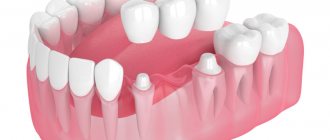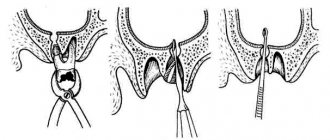What is chronic tonsillitis
The human oropharynx has special structures called tonsils; they protect the body from pathogenic microorganisms. In childhood, these structures are subject to enormous stress, because every day the child comes into contact with new microbes that are not yet familiar to him.
When bacteria “settle” on the surface of the tonsils on the back wall of the pharynx, and the immune system cannot cope with them, inflammation develops - tonsillitis. If this inflammation persists for a long time, acute tonsillitis (tonsillitis) turns into a chronic inflammatory process.
Tonsils in chronic tonsillitis do not perform their functions, but on the contrary, they become a source of infection. This leads to infectious and autoimmune complications.
Description of the disease
Sore throat (acute tonsillitis) is a common disease of the upper respiratory tract, characterized by the presence of an inflammatory process in the tonsils (tonsils).
The main reason for the occurrence of pathology is the penetration of pathogenic microorganisms into the child’s body. When microorganisms enter the oral cavity, they first encounter the palatine tonsils, a part of the human lymphatic system responsible for the safety of the body. The tonsils begin to fight pathogenic microflora, producing special antibodies that remove “pests” from the body. The danger is this: sometimes the immune system cannot cope with the infection, the tonsils become inflamed and themselves become a source of infection.
If the disease is not treated in a timely manner, all systems of the child's body are at serious risk - complications such as rheumatic disease, infectious arthritis, nephritis, meningitis and other health-threatening pathologies may arise.
Let's try to understand the important question of how to cure a child's sore throat, preventing the development of complications and relapses.
Symptoms of chronic tonsillitis
Tonsillitis is accompanied by local symptoms directly in the throat, and general symptoms from other organs and systems.
Chronic tonsillitis is characterized by repeated recurrence of tonsillitis.
Main symptoms:
- pain and discomfort in the throat, it hurts the child to swallow solid food;
- enlargement and tenderness of the cervical lymph nodes;
- increase in body temperature to 37-38 degrees;
- bad breath;
- signs of intoxication - fever, headache, weakness;
- abdominal pain, nausea and vomiting;
- upon examination, redness of the pharynx, tonsils are visible, possibly with a white coating (normally, the tonsils do not protrude from the palatine arches, they are not visible).
The infectious process is not limited to the throat; symptoms of tonsillitis are followed by a runny nose, hoarseness, and cough. Possible development of conjunctivitis, otitis, meningitis.
Angina
CAUSES OF SOLISH
The cause of sore throat is pathogenic bacteria, usually streptococci, which are present in the pharynx in a conditionally pathogenic state and usually do not cause disease, but under unfavorable conditions (hypothermia in autumn-winter and spring, temperature changes) are activated and become pathogenic , as a result, an inflammatory process develops.
THE FOLLOWING MOMENTS CONTRIBUTE TO THE ACTIVATION OF SOLISH CAUSES ON THE MUCOSA:
- Past influenza or other acute respiratory infections;
- Predisposition of the body to sore throat;
- The presence of a purulent inflammatory process in the nasal cavity, paranasal sinuses, oral cavity or pharynx (rotten teeth affected by caries).
CLASSIFICATION OF ENGINES (PHARINGOSCOPIC SIGNS ACCORDING TO B.S. PREOBRAZHENSKY):
- Catarrhal tonsillitis (there is hyperemia of the palatine tonsils, the edges of the arches and the soft palate; the tongue is coated, dry);
- Follicular tonsillitis (inflammation occurs in the area of lymphadenoid follicles with their suppuration and subsequent opening);
- Lacunar tonsillitis (appearance of exudate or plaque at the mouths of lacunae);
- Fibrinous tonsillitis (plaques take on a fibrinoid character and completely cover the tonsil);
- Herpetic sore throat is characterized by herpetic rashes on the tonsils, soft palate and arches;
- Phlegmonous tonsillitis develops when pyogenic bacteria penetrate into the tissue behind the tonsil with the formation of an abscess, both in the tonsil itself and behind it;
- Mixed forms.
To select the correct treatment tactics, an otolaryngologist needs a routine examination, but in some cases laboratory tests are required.
DIAGNOSIS OF SOLISH. METHODS.
- Clinical examination. Includes a survey and examination of the patient with palpation of the lymph nodes, examination of the oropharynx and tonsils, and listening to the lungs. Based on the data obtained, a preliminary diagnosis is made.
- Pharyngoscopy (examination of the oropharynx using a spatula under artificial bright light.
- Bacteriological analysis.
- Nasal cavity test.
- General blood analysis.
When a sore throat becomes chronic or severe, complications are diagnosed:
- Laboratory blood test.
- Echocardiogram.
- Radiography.
CLINIC OF SOLISH
Sore throat, as a rule, begins acutely.
SYMPTOMS OF SOLISH
- General symptoms: weakness, malaise, “heavy” head, increased body temperature to 39-40°C, chills, a feeling of weakness in the body with joint pain and pain in the muscles of the extremities;
- Dryness, rawness, soreness, burning in the throat and pharynx;
- A feeling of narrowing, tightness, squeezing in the throat, making breathing difficult;
- Hoarseness;
- Pain when swallowing (may radiate to the ear, temple);
- Redness of the tonsils, with severe damage, the appearance of purulent plaque on them.
COMPLICATIONS OF SOLISH
With incorrect diagnosis and inadequate treatment of angina, serious complications are possible, such as peritonsillar abscess, retropharyngeal abscess, neck phlegmon, postanginal sepsis (Lemierre's syndrome), streptococcal meningitis, acute rheumatic fever, glomerulonephritis, pyelonephritis, polyarthritis, etc.
TREATMENT OF SOLISH AT THE CLINIC ENT CENTER
Mainly local and systemic antibacterial therapy, anti-inflammatory therapy are carried out, in severe cases - steroid, detoxification therapy, etc.
A frivolous attitude towards sore throat is unacceptable, especially independent treatment. Treatment must be carried out under the supervision of an otolaryngologist. Only timely and correct comprehensive treatment of sore throat will protect the patient from serious complications.
PREVENTION OF SOLISH
- Indoor air humidification. The humidity of the air in which a person is located must be at least 45%, otherwise the mucous membranes dry out and become susceptible to inflammation.
- To give up smoking. Cigarette smoke impairs blood circulation in the mucous membranes and destroys the protective mechanisms of the upper respiratory tract.
- Breathing is not through the mouth (with cooling and drying of the mucous membrane of the oropharynx), but through the nose. The nasal mucosa absorbs many foreign bodies before they enter the throat, warms and humidifies the air.
- Maintaining a gentle voice regime.
- Hardening the body.
Causes of chronic tonsillitis
Tonsillitis
- infection. Among the pathogens that can cause tonsillitis are:
- bacteria (streptococci, staphylococci, diphtheria bacillus, etc.);
- ARVI (influenza viruses, parainfluenza, adenoviruses);
- herpes viruses (cytomegalovirus, Epstein-Barr virus);
- measles virus;
- yeast fungi (candida).
Provoking factors include hypothermia, consumption of cold foods, contact with sick people, stress, and poor nutrition. Candidal tonsillitis may indicate immunodeficiency.
Complications due to improper self-medication and lack of treatment for tonsillitis
There are a simple form of tonsillitis - accompanied only by local symptoms, and a toxic-allergic (complicated) - manifestations of intoxication and dysfunction of all organs and systems come to the fore.
Toxic-allergic manifestations are characteristic of chronic tonsillitis of streptococcal origin. With this form, antibodies to streptococci are formed in the blood, which are also capable of attacking the body’s own tissues. The most vulnerable to such autoimmune aggression are the kidneys, heart and joints. Therefore, chronic tonsillitis leads to the following complications:
- glomerulonephritis and subsequently renal failure;
- endocarditis, myocarditis, pericarditis;
- rheumatism, rheumatoid arthritis, systemic lupus erythematosus.
Therefore, any tonsillitis should be examined and adequately treated. It is necessary to monitor the child’s condition for 3-4 weeks after recovery. If alarming symptoms appear in the heart (chest pain, rapid heartbeat, high temperature), joints (pain with movement, stiffness), kidneys (swelling, lower back pain), seek medical help.
Recommendations for the prevention of tonsillitis
To prevent the development of chronic tonsillitis, you must adhere to the following recommendations:
- avoid hypothermia of the child;
- protect him from communicating with sick people;
- monitor the child’s nutritional status;
- promptly show the child to a pediatrician or pediatric ENT doctor when the first symptoms of a sore throat appear;
- Visit the dentist with him in a timely manner to remove carious teeth, which are a source of bacterial growth in the mouth.
Diagnosis and treatment of tonsillitis
Diagnosis of chronic tonsillitis is made based on symptoms and examination data. To assess the general condition of the child, additional examination methods may be prescribed:
- general blood analysis;
- general urine analysis;
- chest x-ray;
- electrocardiography.
With chronic tonsillitis, a child may show signs of damage to other organs. Therefore, if necessary, a pediatric otolaryngologist can refer him for examination to specialized specialists (nephrologist, cardiologist, ophthalmologist, etc.).
Chronic tonsillitis involves drug treatment: gargling, antibacterial, anti-inflammatory drugs and physiotherapy.
If conservative treatment is ineffective, the child is indicated for a tonsillectomy (surgical removal of the tonsils).
Chronic tonsillitis is a focal infection that must be removed from the body as quickly as possible to preserve the child’s health.
Diagnosis of sore throat
If you suspect a child has a sore throat, parents should immediately seek advice from a qualified specialist.
An experienced doctor will help determine the type and stage of the disease and, accordingly, select the optimal treatment. At the initial appointment, the doctor listens to the complaints of the little patient and his parents, examines the child’s oral cavity using a laryngeal speculum or pharyngoscopy (visual examination of the pharynx using artificial light), palpates the lymph nodes, and also asks about contacts with patients. Based on the medical history, the doctor makes a preliminary diagnosis, after which he refers the patient for additional studies to confirm the initial assumption. The following methods are used in diagnosing angina:
- Bacteriological examination of a throat smear to determine the type of pathogen and determine sensitivity to antibiotics.
- Clinical blood test.
- Blood test for C-reactive protein, ASL-O, rheumatoid factor.
The method of treating acute tonsillitis will depend on the results of laboratory and instrumental studies.








